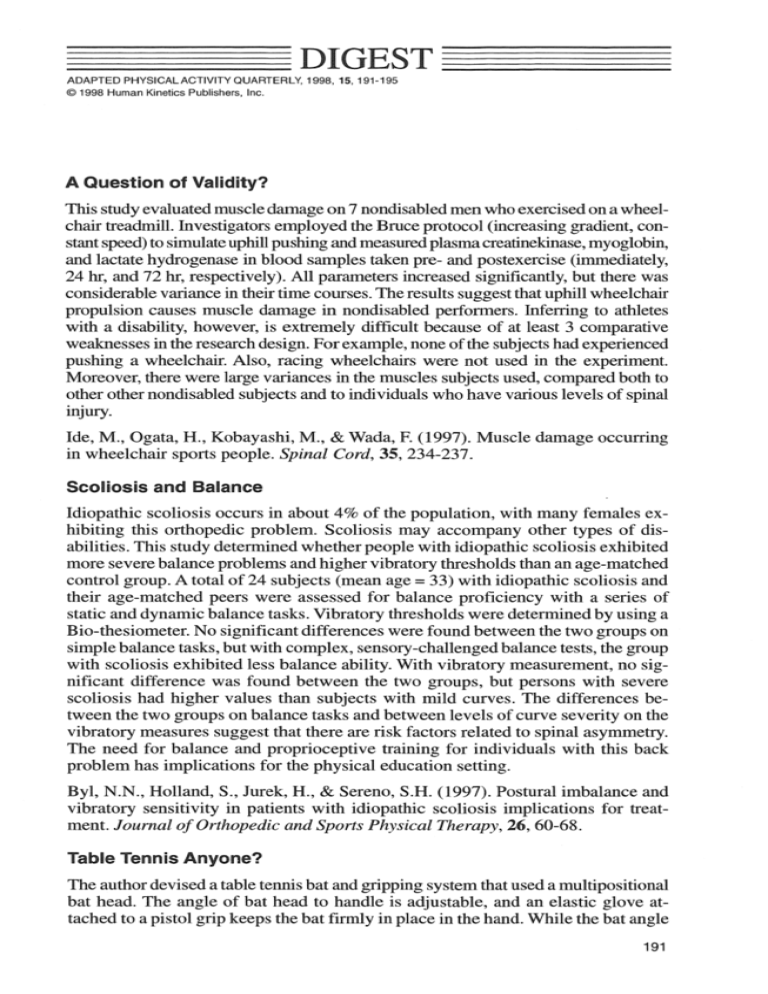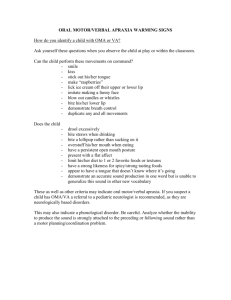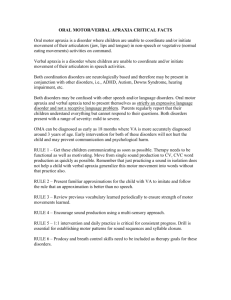DIGEST
advertisement

DIGEST ADAPTED PHYSICALACTIVITYQUARTERLY, 1998, 15,191-195 O 1998 Human Kinetics Publishers, Inc. A Question of Validity? This study evaluated muscle damage on 7 nondisabled men who exercised on a wheelchair treadmill. Investigators employed the Bruce protocol (increasing gradient, constant speed) to simulate uphill pushing and measured plasma creatinekinase,myoglobin, and lactate hydrogenase in blood samples taken pre- and postexercise (immediately, 24 hr, and 72 hr, respectively). All parameters increased significantly, but there was considerable variance in their time courses. The results suggest that uphill wheelchair propulsion causes muscle damage in nondisabled performers. Inferring to athletes with a disability, however, is extremely difficult because of at least 3 comparative weaknesses in the research design. For example, none of the subjects had experienced pushing a wheelchair. Also, racing wheelchairs were not used in the experiment. Moreover, there were large variances in the muscles subjects used, compared both to other other nondisabled subjects and to individuals who have various levels of spinal injury. Ide, M., Ogata, H., Kobayashi, M., & Wada, F. (1997). Muscle damage occurring in wheelchair sports people. Spinal Cord, 35,234-237. Scoliosis and Balance Idiopathic scoliosis occurs in about 4% of the population, with many females exhibiting this orthopedic problem. Scoliosis may accompany other types of disabilities. This study determined whether people with idiopathic scoliosis exhibited more severe balance problems and higher vibratory thresholds than an age-matched control group. A total of 24 subjects (mean age = 33) with idiopathic scoliosis and their age-matched peers were assessed for balance proficiency with a series of static and dynamic balance tasks. Vibratory thresholds were determined by using a Bio-thesiometer. No significant differences were found between the two groups on simple balance tasks, but with complex, sensory-challenged balance tests, the group with scoliosis exhibited less balance ability. With vibratory measurement, no significant difference was found between the two groups, but persons with severe scoliosis had higher values than subjects with mild curves. The differences between the two groups on balance tasks and between levels of curve severity on the vibratory measures suggest that there are risk factors related to spinal asymmetry. The need for balance and proprioceptive training for individuals with this back problem has implications for the physical education setting. Byl, N.N., Holland, S., Jurek, H., & Sereno, S.H. (1997). Postural imbalance and vibratory sensitivity in patients with idiopathic scoliosis implications for treatment. Journal of Orthopedic and Sports Physical Therapy, 26,60-68. Table Tennis Anyone? The author devised a table tennis bat and gripping system that used a multipositional bat head. The angle of bat head to handle is adjustable, and an elastic glove attached to a pistol grip keeps the bat firmly in place in the hand. While the bat angle 192 Digest cannot be changed midplay, this new piece of equipment does represent a considerable improvement on previous bats, because it gives players a greater range of shots. The angle can be changed between games, so the player can offer different types of play and amounts of spin on the ball. The bat can also be used to try a variety of bat head angles before a player goes to the trouble and expense of obtaining a customized fixed angle bat. Taktak, D.M. (1997) An adjustable table tennis bat and grip system for tetraplegics. Spinal Cord, 35,61-63. Dyspraxia and Apraxia Poole and colleagues examined error patterns in persons with developmental dyspraxia and apraxia. Praxis is the ability to motor plan and implies absence of clumsiness. Dyspraxia is a dysfunction in the somatosensorysystem with possible brain abnormalities; apraxia is a disruption in praxis after development. Researchers studied three major groups, each having a control counterpart (n = 6): children with learning disabilities and developmental dyspraxia, college students with dyspraxia, and older adults with apraxia and left-hemisphere brain damage. Participants performed transitive (differentiate between self and object) and intransitive (self only) tasks both by verbal command and imitation. Errors were divided into two types: conceptual (e.g., sequencing) and production (e.g., persevering). Results showed a similar pattern in movement errors in children with dyspraxia and older adults with apraxia, who both made more errors than the other four groups. By substituting gross motor coordination tasks, adapted physical activity researchers and teachers could use the error analysis system from this study to assess praxis in children who exhibit clumsiness. The intervention strategies in this study could be used by adapted physical educators. Poole, J.L., Gallagher, J., Janosky, J., & Qualls, C. (1997). The mechanisms for adult-onset apraxia and developmental dyspraxia: An examination and comparison of error patterns. The American Journal of Occupational Therapy, 51,339-456. Motor Learning From an Occupational Therapy Perspective This study examined the effects of added-purpose (multidimensionaland goal-oriented) on performance. Subjects (n = 20) were occupational therapy students assigned to an added-purpose or rote-exercise condition. Each con&tion had four phases: acquisition (3 sets of 18 trials), 30 min. supervised break, retention (6 repetitions), and transfer (3 repetitions). The treatment (added-purpose) group performed tasks of three- to five-note patterns to produce a musical tune; the rote group learned the motor pattern without hearing the tune. Results showed that the added-purpose group had significantly fewer errors than the rote group. Although generalizing beyond this study is difficult, there are implications for teaching physical education. First, the focus on outcome (playing a tune in this study) should give students knowledge of results. Second, tasks that are meaningful and have added-purpose may enhance motor learning. This study offers ideas for both adapted physical activity and motor learning research in the future. Ferguson, J.M., & Trombly, C.A. (1997). The effect of added-purpose and meaningful occupation on motor learning. The American Journal of Occupational Therapy, 51,508-5 15. Implications for Physical Education for Children With Spina Bifida and Latex Sensitivity This paper discussed latex sensitivity in children with spina bifida and offered suggestions for occupational therapists. However, some suggestions are pertinent to adapted physical educators as well. Alternatives to using balloons, Koosh balls, and other toys with latex components for promoting sensory awareness are dry food boxes, bubbles, and cloth toys and books. Because Theraband and other rubber-band materials are contraindicated,suggested alternatives for building upper-body strength are naturally weighted toys and weights. Although wheelchairs are important for some children's mobility, latex is found in many wheelchair parts, including wheels, cushions, and seat backs. The authors recommended obtaining latex-free cushions, making fabric covers for existing cushions, and wearing gloves for propulsion. Daily care (e.g., diaper changing and catheterization) often requires using latex gloves; caregivers must realize that using them could result in a serious allergic reaction in the latex-sensitive child. Also, physical education equipment contains latex. Therefore, physical educators should examine their equipment if they teach children with spina bifida and latex allergies. Scoggin,A.E., & Parks, K.M. (1997). Latex sensitivity in children with spina bifida: Implications for occupational therapy practitioners. The American Journal of Occupational Therapy, 51,608-611. Use of Support Personnel in Regular Physical Education Classes This study examined the influence of support personnel (paraprofessionals and peer tutors) on Basic-Academic Learning Tie-Adapted Physical Education (B-ALT-APE), also known as activity and knowledge time. Participants were six high-school students, 3 with multiple disabilities and 3 without. The setting was a regular physical education class. Researchers used a multielement research design, with treatment over four activities across the following conditions: baseline, physical education teacher, physical education teacher and paraprofessional, and physical education teacher and peer tutor. Results showed that combining physical education teacher and paraprofessional, and physical education teacher and peer tutor conditions supported B-ALT-APE when compared with physical educator-alone condition. The presence of students with multiple disabilities did not appear to cause adverse effects in the integrated class. Murata, N.M., & Jansma, P. (1997). Influence of support personnel on students with and without disabilities in general physical education. Clinical Kinesiology: Journal of the American Kinesiotherapy Association, 51,37-46. Evaluating Children's Balance This paper reviewed assessment tools of children's balance. The authors assumed a general-systems theory of motor control-sensory, motor, and biomechanicalconsidering environmental conditions. Assessing sensory systems includes vestibular assessment of postrotary nystagmus, vestibular-ocular reflex with EMG, posturography (sensory organization of visual, vestibular, and somatosensory sys- 194 Digest tern using movable forceplate), and a pediatric clinical test. Assessing motor system included observation, posturography, tiltboards, and movement quality. Assessing biomechanical system included range of motion, force output (manual muscle testing, hand-held dynamometer, and isokinetic), and videography. Because postural stability requires sustained, controlled adjustments rather than short bursts of activity, children not developing typically often have difficulty maintaining balance. Such children compensate with gravity mechanisms and alignment substition for sustained muscular contractions (e.g., standing with lumbar lordosis to shift center of gravity behind hip joint and hyperextending knees to move center of gravity more forward of knees). This paper presents valuable information about validity and reliability of many balance assessment instruments. Westcott, S.L., Lowes, L.P., & Richardson, P.K. (1997). Evaluation of postural stability in children: Current theories and assessment tools. Physical Therapy, 77, 629-645. Sequential Behavior Analysis This paper showed that Sequential Behavior Analysis (SBA) is a useful technology strategy for studying effective teaching in physical education. T h s analytic technology can help researchers discern if one behavior follows another more often than expected by chance. Moreover, it provides a means for determining, in situational contexts, the probable effect one behavior might have upon another or several other behaviors based upon their repeatedly close appearances together in time. Thus, SBA could help researchers and teachers uncover subtle and complex behaviors unique to teacher-student interactions. This system has a (one time-consuming) construction of an observation system to use in coding behavior and data collection. Computer-based software and a permanent videotape record are desirable because of the complex nature of teacher-student interactions.Multiple passes through a video tape are often necessary to capture data of interest. Sharpe, T. (1997). An introduction to sequential behavior analysis and what it offers physical education teacher education researchers. Jounuzl of Teaching in Physical Education, 16,368-375. Utility of Old Ideas This paper showed how old research ideas can help emerging research projects in adapted physical activity. The author revisited old research ideas of nomothetic and idiographic knowledge. Nomothetic knowledge is associated with universal principles or laws that can be generalized to all people. Idiographic knowledge is associated with an individual rather than a group of people. According to Bouffard, adapted physical activity researchers should first complete idiographic studies through replication within and across individuals. From these results, nomothetic knowledge can emerge. Bouffard, M. (1997). Using old research ideas to study contemporary problems in Understanding Memory Processes in Individuals With Mental Retardation This study assessed performance differences on learning rate and retention on procedural and memory tasks among individuals with mental retardation. The intent was to clarify the association between problem-solving difficulties and aspects of memory processes. Therefore, no intervention strategies were used. In total, 26 individuals with mild mental retardation and 27 children matched for maturational age participated in the study. Procedural memory was tested using the Tower of Hanoi puzzle and Porteus Mazes. Declarative memory was tested using the Rey Auditory Verbal Learning Test and the Visual Paired Associates, a subtest of the Wechsler Memory 100 Scale Revised. Results showed a similar performance pattern forprocedural and memory tasks. Memory performance in subjects with mental retardation was inferior to the control group's performance. However, learning rate and retention were comparable in both groups throughout all repeated trials. Different overall levels of performance on memory tasks, despite matched MA, suggest that these types of tasks are associated less with MA than procedural and declarativecomponents of memory. Adapted physical activity specialists will frnd this paper interesting in understanding types of memory processes and performance of students with mental retardation during instruction and activities. Vakil, E., Shelef-Reshef, E., & Levy-Shiff, R. (1997). Procedural and declarative memory processes: Individuals with and without mental retardation. American Journal on Mental Retardation, 102, 147-160. Visual Impairment and Children's Strength Blindness does not cause special developmental delays. It is more likely that delays result from fewer opportunities or experiences afforded to children with visual impairments. This paper focused on low levels of muscular strength and resultant motor effect on children with visual impairments. This study assessed isometric strength measurement of the hip and knee extensors of 10 children with congenital blindness, 8 with low vision, and 14 without visual deficits. When strength measures were corrected for body weight, children with congenital blindness demonstrated the lowest strength measures, while no differencesexisted between the low vision and no visual deficit groups. These results suggest that congenital blindness may hinder use and development of the hip extensors during infancy. This study points to the need for early intervention programs of physical activity for individuals who are blind. Wyatt, L., and Ng, G. Y. (1997). The effect of visual impairment on the strength of children's hip and knee extensors. Journal of Visual Impairment and Blindness, 91, 40-46. Digest edited by Terry Rizzo Digest Compilers Paul Bishop, University of Nebraska at Kearney Trevor Williams, Loughborough University Paul Surburg, Indiana University Sherry L. Folsom-Meek, Mankato State University Ellen Kowalski, Adelphi University John C. Ozmun, Indiana State University






